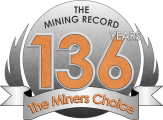Niñobamba Silver Gold Project Ongoing Phase 2 Program
VANCOUVER – Magma Silver Corp. reported on the ongoing work program on the Joramina and Randypata properties on the advanced Niñobamba silver gold project in Peru. Drift sampling on the Joramina zone returned 10 metres of 2.32 grams Au/tonne and 5-metre composite returning 4.085 ounces Ag/tonne. Sampling close to the drift on the Joramina zone returned 0.70 metres of 17.41 grams Au/tonne and 13.94 ounces Ag/tonne. A random composite grab sample returned 0.20 grams Au/tonne and 8.55 ounces Ag/tonne on the undrilled Randypata 2 km silver anomaly.
Stephen Barley, Chairman & CEO, said, “The Niñobamba project is comprised of three contiguous properties now controlled by Magma, totalling 4,100 hectares: the Joramina, Randypata, and the Ninobamba Main. The Q3 work program consisted of sampling and additional geological mapping. The purpose of the exploration program was to validate the previous results and to aid in designing a drill program. Phase 1 and 2 results confirmed the accuracy of the historical Newmont results and, in some instances, exceeded the earlier results. Furthermore, geologic mapping shows that the previous drilling may not have been in the most optimal direction. Our geological team will determine a new drill direction. Community engagement has been excellent, and we appreciate the ir hard work during the initial two phases of work.”
The Phase 2 field campaign lasted 10 days. The Phase 2 program focused on the Joramina and Randypata Zones. Several old mine workings were located and sampled in both exploration phases. A long, well-developed 157 metre drift trending with an azimuth of 120 degrees was located within the main Joramina area, yet it was never documented in any of the previous operator exploration programs. Thirty-one samples were taken from the drift in 5-meter composite chips. The best gold results show two consecutive samples returning 10 metres of 2.32 grams Au/tonne. The best silver result was a 5-metre composite returning 4.085 ounces Ag/tonne. The drift is within the area of the proposed drilling and is in excellent condition and may be used in the future for underground drill sites.
Additional surface sampling was conducted approximately 100 metres northeast of the drift confirming that the silver-gold mineralization is structurally controlled with several fractures and veinlets trending NE-SW dipping Northwest. One chip sample across 0.70 metres returned 17.41 grams Au/tonne and 13.94 ounces Ag/tonne. Galena (Lead Sulphide) and Sphalerite (Zinc Sulphide) are present in the veins but have not yet been assayed for these elements. The Company will assay some of the samples for lead and zinc when check assays are being performed.
Phase 2 program also included a brief surface review of the Randypata Zone. Twenty-one samples were taken over the historic 2-kilometre Ag anomaly. This area is untested by drilling. The best result came from an area where a road cut exposed a strongly oxidized breccia, where a random composite grab sample returned 0.20 grams Au/tonne and 8.55 ounces Ag/tonne. Follow-up work is required in this area to determine the extent of the Ag mineralization.
Magma is pleased with the results of the first two phases of the initial exploration programs. The Company is now convinced the previous drill programs did not adequately test the Joramina zones. A drill program will be designed to test the gold-silver mineralized structures with the optimal drill direction.
Seventy samples were collected during phase 2 and analyzed at the Independent Mining Lab Services based in Huancayo in south-central Peru. The analysis method was by fire assay, and every 10th sample will be re-assayed at another independent assay lab in Lima, Peru, for quality control.
Related Posts
TORONTO - Barrick Mining Corporation COO, Interim President and CEO, Mark Hill, said, “Higher gold…
TORONTO - Kinross Gold Corporation CEO J. Paul Rollinson, said, “The Company delivered another excellent…
Large-scale industries operate under high variability, stringent constraints, and relentless demands for efficiency, safety, and…



